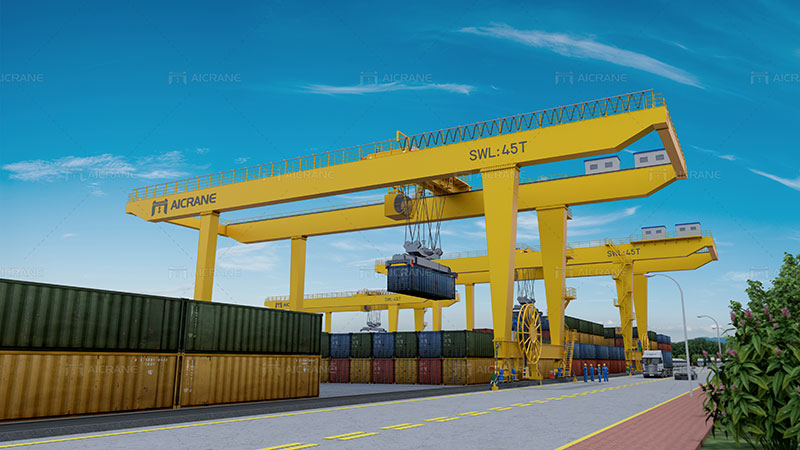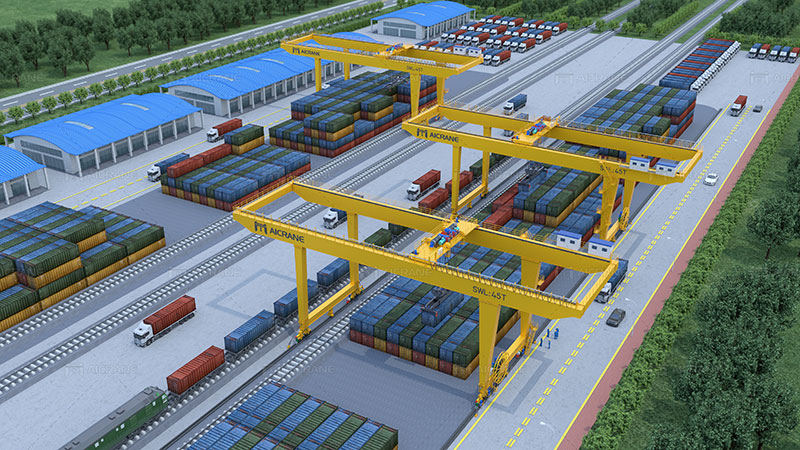In the ever-evolving world of logistics and industrial operations, efficiency and precision are paramount. This is where Rail-Mounted Gantry (RMG) cranes come into play. RMG cranes are the heavyweights of the material handling industry, renowned for their remarkable structure and features that enable them to lift and transport heavy loads with ease. In this comprehensive article, we will explore the intricate structure and impressive features of RMG cranes, shedding light on how they revolutionize cargo handling across various industries.
The Anatomy of an RMG Crane
To truly appreciate the capabilities of RMG cranes, it’s essential to understand the intricacies of their structure. These massive machines are marvels of engineering, purposefully designed to handle large, often containerized, cargo efficiently.

Gantry Structure:
The defining feature of an RMG crane is its gantry structure. This immense, steel framework spans the width of the rail tracks upon which the crane operates.
The gantry structure is typically supported by robust legs at each end, ensuring stability and structural integrity.
Crane Trolley:
Suspended from the gantry structure is the crane trolley, the workhorse of the RMG crane. This trolley houses the lifting mechanism and moves horizontally along the length of the gantry.
The trolley’s movement along the rails allows for precise positioning of the crane over the cargo to be lifted.
Lifting Mechanism:
The lifting mechanism is the heart of an RMG crane. It is responsible for hoisting and transporting heavy loads.
Depending on the application, the lifting mechanism can be equipped with various attachments, such as a spreader beam or hook, designed to grasp and secure the cargo securely.
Power Supply:
RMG cranes are electrically powered, and their power supply systems are seamlessly integrated into their structure.
Power transmission methods can vary, including cable reels, festoon systems, or conductor bars, to ensure uninterrupted operation.

Key Features of RMG Cranes
RMG cranes are revered for their ability to streamline material handling processes, making them indispensable in container terminals, intermodal yards, and industrial warehouses. Here are the key features that set them apart:
Precision and Accuracy:
RMG cranes are precision instruments. They excel at positioning loads with astonishing accuracy, often at millimeter-level precision.
This accuracy is especially crucial in busy container terminals, where containers must be stacked neatly and efficiently to maximize space and expedite cargo handling.
High Productivity:
The remarkable productivity of RMG cranes is a major reason for their widespread adoption in industrial settings. These container gantry cranes can move numerous containers or heavy loads in a relatively short amount of time.
Their ability to work efficiently and swiftly reduces downtime, increases throughput, and ultimately enhances the bottom line for businesses.
Versatility:
RMG cranes are highly versatile machines that can be customized to handle a variety of cargo types. Whether it’s different container sizes, bulk materials, or heavy machinery, RMG cranes can adapt to the task at hand.
This versatility is a significant advantage in industries where cargo diversity is the norm.
Safety Features:
Safety is paramount in material handling operations. RMG cranes are equipped with advanced safety features that minimize the risk of accidents and injuries.
Anti-collision systems, overload protection mechanisms, and emergency stop functions are just a few examples of the safety features integrated into RMG cranes.
Minimal Maintenance:
Designed for durability, RMG cranes require minimal maintenance, translating into lower operational costs over their lifespan.
Their robust construction and efficient components ensure longevity and reliability, reducing the need for frequent repairs.
Environmentally Friendly:
In an era of growing environmental consciousness, RMG cranes stand out as eco-friendly solutions. Their electric power source significantly reduces emissions compared to traditional diesel-powered machinery.
This green aspect makes RMG cranes an attractive choice for companies aiming to reduce their carbon footprint.
Remote Operation:
Many RMG cranes are equipped with remote control systems, allowing operators to control the gantry crane from a safe distance.
This remote operation not only enhances safety but also provides operators with a better vantage point for precision handling.
Conclusion
Rail-Mounted Gantry (RMG) cranes represent the pinnacle of efficiency and precision in the material handling industry. Their imposing structure and impressive features make them indispensable assets in ports, container terminals, intermodal yards, and industrial warehouses worldwide. As industries continue to evolve and technology advances, RMG cranes are likely to play an even more pivotal role in optimizing logistics, streamlining operations, and contributing to the global economy. These giants of industry epitomize the marriage of engineering ingenuity and practical utility, embodying the future of material handling.